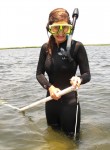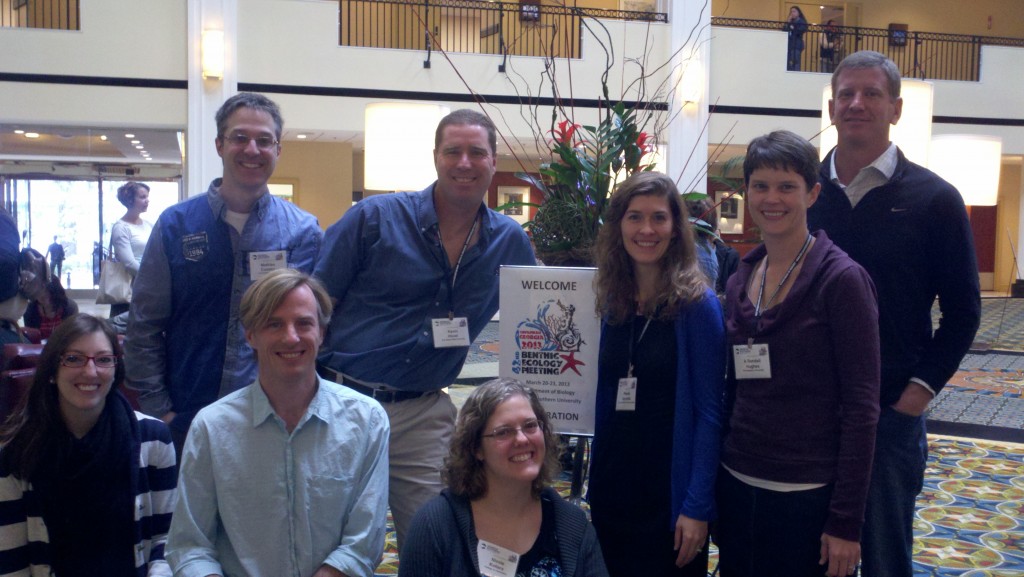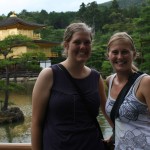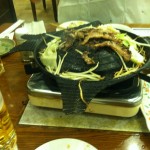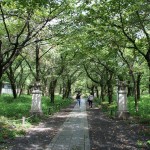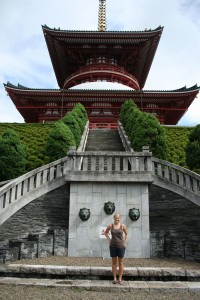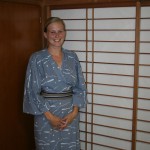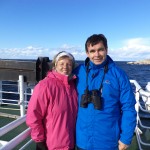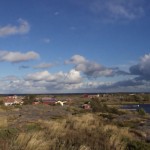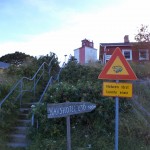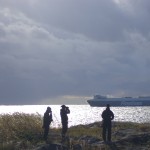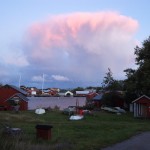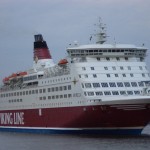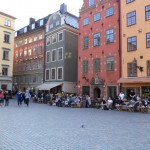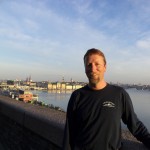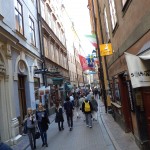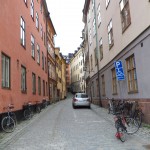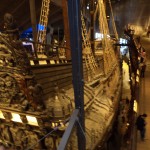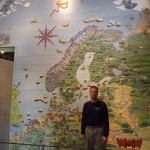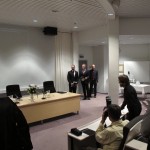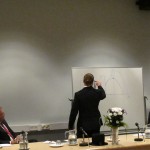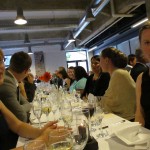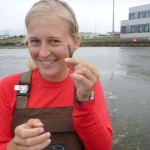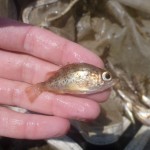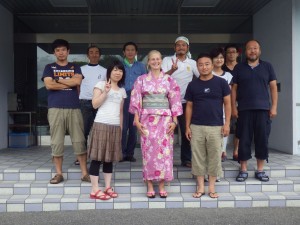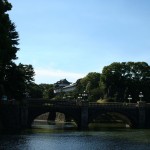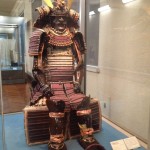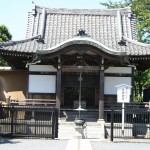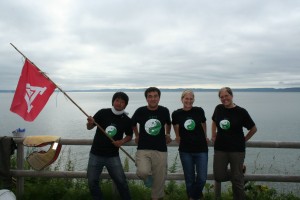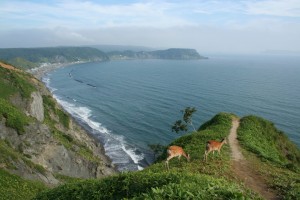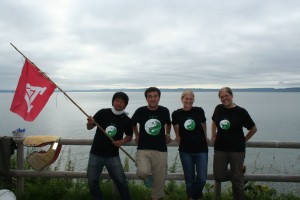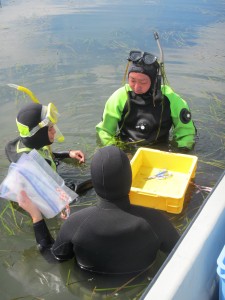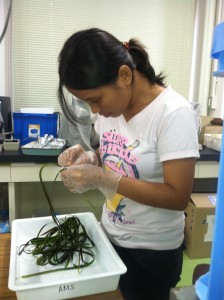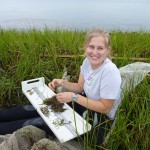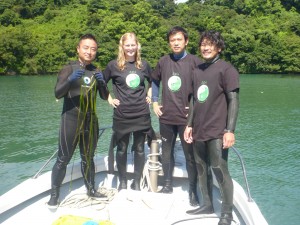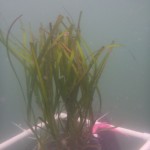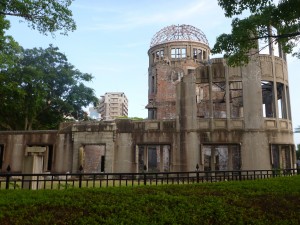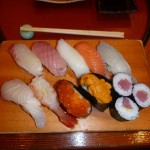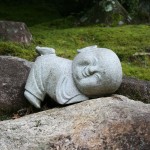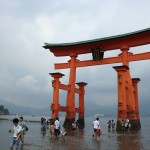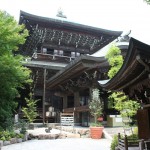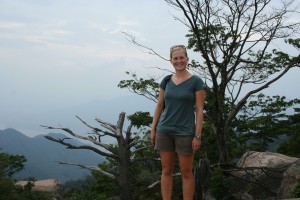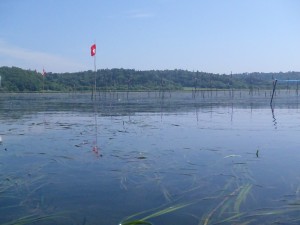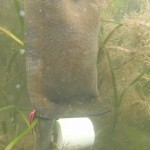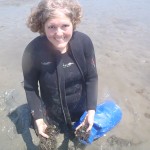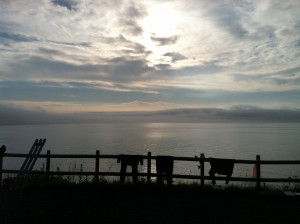Kayaking in the Archipelago Sea
by Paul Richardson (VIMS technician)
The weather is beginning to warm here in Virginia, which means that soon I will be able to dust off my kayak and take it for a paddle in the nearby York River. The last time I went kayaking was over the summer when I was in in Finland. While there I was fortunate to have two wonderful and very hospitable neighbors in Korpoström, Heidi Arponen and Kevin O’Brien, who work for the Finnish Forestry Service known as Metsähallitus (Finnish), or Forststyrelsen (Swedish). In addition to taking me to lunch, having me for dinner and sharing many cups of tea, Heidi also invited me to go sea kayaking in the Baltic on her her SKUK Explorer. It was amazing. Heidi and Kevin mounted a GoPro camera on the front of my boat so that I can share the experience here. The GoPro took a still every 5 seconds. I hope you enjoy this virtual tour of the Baltic.
ZEN Benthic Ecology Meeting 2013
by Pamela Reynolds (ZEN coordinator)
Meetings are wonderful excuses to meet up with old friends, make new ones, and, of course, talk science! Last week I presented some of the emerging results at the annual Benthic Ecology Meeting in Savannah, Georgia. The meeting was a great opportunity for many of the ZEN partners to network with each other and other attendees of the meeting, which focuses on marine ecology research along the East and Gulf coasts. Drs. Mathieu Cusson (Quebec), James Douglass (Massachusetts/Florida), Kevin Hovel (California), and Erik Sotka (North Carolina) were all in attendance, along with two new ZEN partners, Drs. Randall Hughes (Massachusetts) and Joel Fodrie (North Carolina), two of the ZEN student exchange fellows (Rachel Gittman, Nicole Kollars) and other grad students who have helped with the ZEN research (Jon Lefcheck, Laetitia Joseph). I was excited about the depth and breadth of talks, especially by those presented by the ZEN partners, which ranged from experiments on the role of functional diversity and salt marsh mutualisms, to whether crabs can hear and the effects of seagrass habitat fragmentation on epifauna. (See a full list of talks and abstracts on the BEM website) Additionally, our short music video “GRAZER” was one of 14 films chosen for the main Beneath the Waves Film Festival screening at the conference. I’ll post the film here shortly so check back.
North and South Unite! A 4-day epic adventure across Japan
by Nicole Kollars and Rachel Gittman (ZEN graduate student fellows)
With the lab processing finished in Akkeshi (see Rachel’s blog “Sayonara Hiroshima”) we said goodbye to our ZEN colleagues and began a whirlwind sight-seeing adventure of the Japanese countryside. We must confess that we were a little intimidated at first. We relied so much on our new friends to translate for us and explain Japanese customs that venturing out on our own to explore the country was a little scary. Equipped with a pocket dictionary, a few maps, and a Japanese rail pass we boarded the train at the Akkeshi station excited and full of anticipation for the sights and sounds that were ahead of us.
First-stop: Sapporo!
After a 5-hour train ride across the beautiful, green hillsides of Hokkaido, we made our first stop in Sapporo. Sapporo is the largest city on Hokkaido and is most famous for its breweries. That night we stopped at the Sapporo Beer Factory for a lovely feast of fresh lamb and vegetables that were brought out raw for us to cook over a heated grill right at the table. We enjoyed the delicious food and beverages while talking about our research, life as a graduate student, and our plans for the upcoming semester.
The next morning we toured the botanical gardens of Hokkaido University. It was a little late in the season to see the flowers in bloom, but the pathways through the woods were beautiful. However, we quickly learned that Rachel’s injured ankle was not up for the task. A few days before, Massa-san had taken us to the intertidal to show us the different types of eelgrass found in Akkeshi Bay. Rachel had twisted her ankle in the rocks and the squeezing of the waders we were wearing had only intensified the injury. We decided that the ankle definitely needed some doctoring before we continued our walking explorations, which was an adventure in itself. It took some trial and error in communication while asking for directions, but we finally made it to a drug store to buy wraps and bandages. Rachel looked forward to the upcoming train ride to rest.
A “Harry Potter” train ride
We were fortunate enough to have the opportunity for an experience that not many tourists enjoy – the 22-hour Twilight Express train ride from Sapporo to Kyoto. This train travels along the Sea of Japan down the entire coastline of the main island of Honshu. It was very difficult to get tickets for this train. It is popular among the Japanese during their vacation time and Hori-san had to be very insistent during a conversation with the booking agent to ensure we had reservations. We are so grateful for his effort! The coastline was spectacular, especially as the sun began to set. Our eyes were glued to the window as the train reached the more southern towns and villages. We had excellent accommodations for the journey in a shared compartment with room for 4 people. We shared the room with an older man who did not speak much English but was very kind and insisted that we see the “Golden Pavilion” when we stopped in Kyoto.
Temples, Bamboo, and Geisha
Kyoto is known as the cultural capital of Japan. We only had 20 hours to see as much of the city as possible and we did not waste a minute of it. After settling into our youth hostel and grabbing a quick lunch at the “ZEN Café” (!), we put on our sunscreen, grabbed our fans, and began walking through the city. The receptionist at the hostel mapped out a touring path for us and we were not disappointed. Our journey took us through a maze of temples, shrines, gardens and shops. In the evening, we ended up in the Geisha district of Gion and saw a Geisha cultural performance at a local theater. The show involved a traditional tea ceremony, harp-playing, dancing, and short plays. Dark had fallen while we were in the theater, and we walked out onto cobblestone streets lit by paper lanterns. After dinner in downtown Kyoto we made our way back to the hotel to ice our ankles swollen from a day of walking. Nicole also had an injured ankle from a sprain involving a slippery staircase a few weeks before.
The next morning we boarded the train for the western part of the city. There we explored a ZEN temple and garden that included a long grove of bamboo. The dense canopy of bamboo was magical and a highlight of our Kyoto experience! From there we ventured to the Golden Pavilion as recommended by our friend on the train. It was well worth the long walk from the train station, the temple was so dramatic in its intensity. After bowls of ramen noodles (these noodles were definitely not your typical college student’s ramen) and green-tea flavored soft serve ice cream, we caught the bullet train to Tokyo.
Our last 24 hours in Japan
With the speed of the bullet train we made it to Tokyo in just over three hours and just in time for rush hour. Our connecting train from Tokyo to Narita (where we would be staying for the night and where the airport was) was packed face-to-face. It took us nearly 2 hours of wading through a dense sea of people with gigantic luggage bags before we reached this outskirt of Tokyo. Exhausted, we both agreed to pay for a taxi to take us from the train station in Narita to our ryokan for the night. A ryokan is a hotel of traditional Japanese style and we slept on futons in a tatami matted room. Across from the ryokan was a beautiful suite of temples, shrines, and gardens – perfect for exploring the next morning before we had to leave the airport.
We arrived at the airport with 6 hours to spare. We wandered around the airport shops, had our last lunch in Japan, and re-pack our luggage to shove in all the extra souvenirs we were bringing back to our families and friends. Finally, it was time to go our separate ways – Rachel to San Francisco and Nicole to Los Angeles to catch connecting flights to our homes in North and South Carolina respectively. Grateful for the journey through Japan together and the friendship forged, we knew we would see each other again soon – whether it be at conferences, while visiting each other’s laboratories, or in another eelgrass bed.
Check out some more images from Nicole and Rachel’s last few days in Japan:
Exploring Finland’s Outer Islands
by Paul Richardson (VIMS technician)
If you’re ever in the Archipelago Sea of Finland, then you must visit the outer exotic islands. I took advantage of a few slow days before the experimental breakdown to take an overnight trip to Utö Island on one of the free boats that make regular rounds of these islands. Utö is an island on the outer archipelago with a town, a light house and an old military base that was used in battles with the Russians and others.
The boat I took, the M/S Eivor, is a refurbished Norwegian fishing vessel that is very sea worthy. It has a nice cafeteria, inside benches and seats and, my favorite part, the open air upper deck that is three stories above the water with diner style benches and tables.
The boat passed and stops at many islands along its five hour trip. It is nice to see all of the islands, but if you get off of the boat, you will be left until the next day. So, it’s good to bring an overnight bag for this trip and it’s also preferable to contact people ahead of time at whichever island you choose. I contacted Hanna Kovanen at Utö Island. She, like most everyone else that I met in Scandinavia, speaks fluent English. She’s very nice, and she’s a native of the island. When she was younger she went to California for a foreign exchange program. Hanna is a very bright multi-tasker in that she served as my tour guide, hotel clerk, and chamber of commerce minister once on the Island. The tour of the lighthouse was 6 Euros and my room was 25 Euros. As I said, the boat ride is free so this is a very inexpensive trip. Who said Scandinavia is too expensive to visit?
While on the boat I made some new friends, Antti and Tuula Karlin. Antti is an orninthologist and Tuula is a school teacher. They are native Finns. Antti was very surprised to meet an American and, like some others in Finland, he referred to me as “exotic”! Overall, my experience was that most Finnish people who speak English love to talk to Americans (like me!) and they’re all extremely kind. The Karlins were no exception and I genuinely enjoyed chatting visiting with them. We exchanged emails and we’ve been trading pictures and information ever since.
One interesting fact about Tuula is that she “collects” swimming holes. She goes swimming all over Scandinavia and other places, despite the temperature. She keeps a swimming journal with her collection of sites. When I saw her on the boat ride back on the next day she informed me that she went swimming at Utö. Meanwhile, I was wondering whether my sweater, long johns, hat, and jacket, were enough clothes for the frigid air temperature! Boy, I’m such a wimp when it comes to cold water!
Utö Island
I spent the night on Utö Island. It’s one of the outer most islands of the archipelago. It has a very rugged beauty and is steeped in a rich history. On the island there is an old military base, some weather stations, fishing shacks, plenty of beautiful vistas, a 19th century lighthouse and lots of history. The lighthouse that stands there now was built in 1814 – the original light house built in 1753 was blown up in the Finnish war. The island even has its own endemic toad. What they don’t have are ticks. Nice!
Connection to the United States
On Christmas Eve in 1947 a United States ship, the SS Park Victory, was just off of the Utö lighthouse trying to maintain its position in the icy waters when its boiler exploded and blew a hole through the side of the ship sinking it. Ten of the 148 men died and the other 138 were rescued by the people of Utö. They took them into their homes and gave them shelter and food. This was recognized by the U.S. government on at least two separate occasions and the letters are framed on the wall of the chapel in the lighthouse.
According to Hanna, this was the first time that the people of Utö ever saw a black person. According to personal accounts that Hannna referenced in her tour, there was some confusion among the black sailors when they entered the houses and found that there were no segregated tables where they could sit. This also created confusion for the citizens of Utö! Needless to say, all of the survivors were seated at the same tables. Hanna also indicated that she is related to one of these black survivors.
Off to Stockholm
The next day I got on the much larger (cruise ship size) M/S Isabella, which is a Viking Line “ferry” that carries some cars and mostly pedestrians from Turku to several ports at various locations within the 10 nations that border the Baltic Sea. My boat was headed to Stockholm, Sweden. It’s a pretty sweet deal, really. I paid 70 Euros for a round trip ticket. The ship picked me up at 8pm on Monday night in Turku. Once on board, I dropped my bag off in my cabin which was very nice with a private bathroom and fresh sheets. I then checked out the restaurants, casinos, discos, and the huge mall-like tax free shopping center, and then I went to bed. I’d walked all over Turku all day and so I was quite tired.
I awoke at 7am when the ship was approaching Stockholm. It amazed me how close the ferry went to the rocky shoreline. At several points, I could have easily tossed a baseball onto someone’s summer cottage. The ferry docked shortly thereafter and I had the whole day to explore Stockholm and I didn’t have to be back to the boat until 8pm. I walked all over the city. I inquired about the buses and trains and water taxis, but I chose to see a city on foot. Taking it slow allowed me to really see lots of cool details that I would have missed on the bus.
Stockholm is a very old, very beautiful capital city of 870,000, located on 14 islands in the south east of Sweden. The first thing that I noticed was the beauty. The second thing that I noticed was that there were literally more bikes than cars. There were so many of them flying down the hill as I walked into the old town, that I actually felt safer crossing the automobile road with its crossing lights than I did crossing the bike lanes! But I think it’s great! In the States, it’s the opposite. We have the tyranny of the automobile and good luck if you commute by bicycle.
I don’t have the data here to back it up but qualitatively, I’m sure that the Finnish and the Swedes are more physically fit than my fellow Virginian Americans thanks in part to the higher prevalence of bicycle usage. I didn’t drive a car for my entire 40 days in Scandinavia and instead rode a bike or walked, which is probably the reason that I lost 10 pounds during the trip. It was high school the last time I weighed so little!
The city was lovely and the main activity that I did while there, aside from eating and walking, was my visit to the Vasa museum. The Vasa is a one of a kind attraction. In 1628, the king of Sweden, Gustavus Adolphus, in his haste, launched the state of the art warship, Vasa to send to Poland to fight in some Catholic Protestant battles. At 226 ft long and 172 ft tall with 36 guns (twice the recommended amount) and fatefully, not enough ballast, the top heavy vessel floundered and sank near her railway on her maiden voyage. In the absence of ship worms and the presence of anoxic conditions resulting from the pollution in the harbor, the ship was nearly perfectly preserved.
In 1961 archeologists knew that the Vasa laid somewhere in the harbor and so they started taking cores of the sediment to see if they could get a plug of some white oak which is the wood that the Vasa was made of. After many attempts, they finally located and excavated her. Using SCUBA and some type of fire hose pump they insert several harnesses under the hull and ultimately hoisted the behemoth, nearly intact, to the surface. They’ve been restoring her ever sense.
The thoroughness of the museum was simply mind boggling. I spent three hours there and I could only scratch the surface. It is six stories from the keel to the top deck. They had to replace all of the water in the wood with polyethylene glycol. There were skeletons of the people who were on board and perished in the disaster. There were models, and maps and MRIs of the hull. In some ways it almost resembled a modern ship yard with lifts and heavy equipment and restorers flitting around working. There were so many exhibits with artifacts that it was overwhelming. By 1pm I was quite hungry and I needed to see sunlight again. I had intended to get some food and return, but when I went outside it was so beautiful that I vowed not to go into any more museums! I spent the rest of my day in Stockholm sightseeing and taking tons of pictures. Towards the latter part of the day, close to the time when I would catch the ferry, I went from pub to pub trying various delicious food and beverages.
As I got on the ferry in Stockholm on Tuesday night I received a phone call from Christoffer. He wanted to warn me that I must come directly to the lab and prepare for the field on Wednesday as soon as I got back from Turku. We would go to the field that afternoon and begin the ZEN breakdown since there was very bad weather predicted for Friday. My mini-vacation was over and it was time to get back to work on this last phase of my involvement with the ZEN project in Finland.
A Dissertation Defense, Finish Style
by Paul Richardson (VIMS technician)
After many years of graduate school, students are expected to defend all of the work they’ve done before they receive their degree. Doctoral defenses in the States are pretty intense and generally consist of a public lecture followed by public and private questioning session that can last for hours. I’d been told that European defenses can be much more elaborate and so, when I heard that one was scheduled for a Finnish student here at Åbo Akedemi I decided that I must go! Camilla, a graduate student here helping with the ZEN work, invited me with the instructions to bring my dress pants and dancing shoes. And my new Swedish language skills as the defense would not be in English. So, I woke up early and rode my borrowed bike in my dress pants with my backpack the 10 km to the little town on Korpo Island to catch the bus for the two hour ride to Åbo Akedemi’s Bio City in Turku.
Once I got to Turku I went to the Domis, which is Åbo Akademi University’s housing for guests. The Domis is a very Spartan grey concrete institutional building with more locks that Fort Knox (a military base in the USA). Once I penetrated the outer perimeter I met the very friendly Anita Bruman Tott who checked me in. One of the first things I recall her asking me was, “hey, are you the TV guy?” I guess my cameo on the Finnish TV talking about seagrasses has made me slightly famous here!
The fee for staying at the Domis was quite reasonable at 30€. It turns out the room was just as Spartan as the rest of the building and the bathroom was a little cramped, but the bed was very comfortable, the view was pleasant, and later that night, I slept like a baby.
Since the defense was a formal affair, I recognized that I was grossly underprepared in the wardrobe department The only suit I’d brought with me was my wetsuit and, despite the fact that we are marine ecologists, showing up to the defense salty and smelly probably wasn’t the best way to go, even if it would have been funny (and uncomfortably hot!). Christoffer let me raid his closet and I came up with a tie and a slightly too small sport jacket. In need of a dress shirt, after checking into Domis I went straight to the mall. The salesman had a good laugh when I came out of the dressing room with the brand new shirt on (with all of the tags still attached) under the tie and sport coat. He cut the tags and rang me up.
All dressed up I headed downtown toward Bio city, grabbing a snack along the way as I had been warned that the defense would take several hours. Realizing that the defense would be starting soon, I picked up the pace. Camilla called me and, after asking where I was, told me to quickly get on a bus as I wouldn’t make it in time. They are very punctual here in Finland and if I was even a minute late I risked being locked out of the “proceedings!” So, I backtracked quickly to a bus stop and crossed my fingers that the first bus I hopped on was the most direct one to the university.
Thank goodness for the effective mass transit of Turku! , I made it just in time. The door closed right as I sat down. Right away, three well groomed gentlemen walked inside wearing very nice suits – one even had a top hat! Everyone in the auditorium stood. We stayed standing until someone gave a signal to sit and everyone sat in unison. I started to wonder – is this a dissertation defense or a court of law? Cameras started clicking away, preserving this momentous occasion, and so I went to get mine. That’s when I realized that I’d left it on the bus! That was bummer. Luckily Camilla had a camera and shared her photos with me.
Before I forget, the student defending his defense was Matias Scheinin. His advisor, Johanna Mattila, was wearing the top hat. The third gentleman was the “challenger,” an external reviewer flown in to test the student’s knowledge, from Sweden, Peter Eklöv.
After introductions, Matias launched into the formal hour-long presentation of his work on the “Patterns and processes of littoral zooplankton composition in relation to the trophic state of the environment.” The defense was in Swedish, but luckily for me, the presentation slides were in English. His work on the zooplankton ecology of the Baltic was very interesting. One of his experiments involved natural mesocosms, which consisted of coves in islands (called flads) that had varying communities with varying levels of predation by different fishes including roach (Rutilus rutilus) and perch (Perca fluviatilis). The take home message from that experiment for me was that differences in vegetation (presence or absence of submerged aquatic vegetation) affected the feeding rates of perch, but did not affect roach feeding. I’d seen a lot of roach around the docks at the field station, so it was very interesting to learn more about their ecology.
After the formal presentation the challenger, Peter Eklöv, critiqued Matias’ dissertation for the next two and half hours in front of the entire audience! This was very different from the defenses I’d seen back in the States where the professors grill the student in a closed door session after the public presentation. All of the interrogation was in Swedish, so it was difficult for me to follow. Eventually the whole thing was adjourned and we went to begin the celebrations – Matias had passed the exam and was now going to be a PhD!
In close vicinity to the auditorium the toasts began. In English we say cheers, but in Swedish they say skål (pronounced skole or skull). Then everyone dispersed and met back at the reception hall a few hours later. At the reception there was another toast outside in the lavish entry lobby and then, once again, the well-dressed crowd walked in and stood behind their chairs until given the signal to sit and the toasts resumed. Then there was an introduction to the buffet menu, which included rostad sik med pepparratssmörsås och honungsrostad rödbeta (roasted whitefish with peppercorns and honey roasted beetroot) for the main course and a wonderful äppelpaj med kardemummås (apple pie with cardamom) for dessert. Dessert was served with a selection of Scotch whiskies and cognacs and coffee, plus many more toasts, roasts, skits and power point presentations. Matias experienced a thorough hazing, all in good humor of course.
After dinner Matias’ brother-in-law and his all physician rock band played many great tunes ranging from the Rolling Stones, to Parliament, to Alanis Morrissette interspersed with very good Finnish rock songs (I couldn’t understand the words but they totally rocked!). Ultimately things wound down around 1:30 AM . While the others headed off to the “after-party” celebrations, I carried my old bones back to my Domis room to sleep.
Sayonara Hiroshima, Konnichiwa Akkeshi
by Rachel Gittman (ZEN graduate fellow)
After nearly a month in Hiroshima, it was almost time for me to make my way to Akkeshi to help Dr. Nakaoka and Nicole Kollars, the other ZEN graduate fellow in Japan, process samples post-breakdown of the ZEN main experiment. The experiment tests the interacting effects of mesograzers and nutrients on seagrass ecosystem function through the use of a grazer deterrent rather than traditional caging techniques. Before I left Hiroshima we had one more experiment to run testing the roles of predators in local eelgrass beds, and then I was off to Tokyo for a few days with Hori-san.
Conducting assays to test the strength of predation by small fishes and crustaceans on mesograzers at our field site was a fairly straightforward process, but was particularly challenging when the tide was up and the current strong. We experienced both of these conditions during our last predation assay. The water was too deep for setting up the assay by snorkel, so Hori-san and Hamaoka-san completed the assay with SCUBA. Shimbukoro-san and I used snorkels to set and collect minnow traps, which provide data on the abundance and composition of the ambient predator community. We caught several small fish in each of the minnow traps, primarily gobies and rockfish, but we decided to conduct additional fish sampling using a modified seine to get a better representation of the fish diversity at this site.
On my last day in Hiroshima, the lab surprised me with a Yukata, a summer time kimono and a farewell dinner. The next morning as Dr. Hori and I headed to the airport, I grappled with the realization that my time in Hiroshima was ending. This was not an experience I was likely to forget, but I knew that I would genuinely miss my new friends.
Finding my way in Tokyo
Before heading to Akkeshi to help Dr. Nakaoka with the ZEN experiment’s at the northern Japan site, I spent a few days in Tokyo. Tokyo is overwhelming to say the least; just stepping off the train into Tokyo Station makes you realize how large and bustling of a city it really is. You could spend an entire day just in the train station with all of the shops and restaurants, but fortunately I had time to make it out of the station and see two of the major tourist attractions in Tokyo: the Imperial Palace and Ueno Park.
Although you can only enter the palace two times of the year (new Year’s day and the Emperor’s birthday) without a scheduled tour, just seeing the outside of the palace was worth the walk in the hot August sun. Ueno Park is a large park in central Tokyo that includes numerous museums, temples, shrines, and a zoo. Although I didn’t have time to see it all, I enjoyed the exhibits in the Tokyo National Museum and visiting the shrines and temples throughout the park.
Akkeshi: a different climate
From Tokyo I headed north to the town of Akkeshi where I would spend the next week assisting with the ZEN research. Compared to the fast pace of Tokyo, Akkeshi is like a different world. Akkeshi is a small, quiet fishing town on the Pacific coast of Hokkaido, the northernmost island of Japan. The marine lab where the northern Japan ZEN team was based is located just outside of Akkeshi, within a National Park.

ZEN graduate student exchange fellows Nicole Kollars and Rachel Gittman marvel at how tall the eelgrass is in Japan
After a warm welcome from Dr. Nakaoka, his wife, the lab and a minor earthquake (although it didn’t feel so minor to me), I jumped into sample processing. The fieldwork for the main experiment (see Nicole’s blog) was complete, but we had a lot of samples to process in a very short time. Although I had processed samples for ZEN in North Carolina before, sample processing in Akkeshi was a little different. Simply put, everything is just bigger in Akkeshi. The seagrass is bigger, the grazers are bigger, and, naturally, the epiphytes are bigger. Filtering the epibionta scraped from the eelgrass shoots was a challenge because of the large scale of all of the organisms.
Fortunately, because of the dedication of the lab, we were able to complete sample processing in the week that I was there and I still had time to hike to the top of the cape above the lab with Nicole and witness to breathtaking sunsets. We also made sure to sample some of the delicious ice cream made fresh from a local dairy just outside of town.
Before I knew it, it was time to leave Akkeshi, but not before we spent our last night eating sushi and celebrating with the lab at a wonderful local restaurant. Although my trip was not quite over, this was my last day working with the ZEN team in northern Japan. I truly enjoyed the experience and learned a great deal from our Japanese collaborators. Hands-on experience conducting multiple field experiments in entirely different environments (North Carolina, Hiroshima, and Akkeshi) was eye-opening for me and gave me a new perspective on collaborative research. I have tremendous respect for the ZEN partners all over the world trying to make this project a success in their own unique environments.
I’ll end the blog here, but see my and Nicole’s final joint-blog for the highlights from our travels in the land of the rising sun.
Meditating on ZEN
by Nicole Kollars (ZEN graduate research fellow)
As my time with the ZEN team in Japan draws to a close, I am beginning to look back at what I have gained from this experience. Aside from being exposed to the dynamics of a temperate eelgrass ecosystem, I learned the ins-and-outs of subtidal field work. I collected samples for my own master’s thesis research and discovered new techniques that will be helpful for future projects. I experienced the daily life of someone who lives on the other side of the world and have mastered the use of chopsticks and the art of cooking rice. I met amazing people, saw amazing places.
All of this is wonderful, but what I am most grateful for is the experience of international collaborative science. It is really awesome to be a part of a project that brings together researchers from different countries, different cultural backgrounds, different life experiences, and different languages. Understanding the effects of nutrients, grazers and predators on the ecology of eelgrass beds provides the mission, but I think it is the universal characteristics of being a scientist (curiosity, passion, and hard work) that truly unites us. It has been an honor JN team!
ZEN – a truly international effort
by Nicole Kollars (ZEN graduate research fellow)
“Many hands make light work.”
I like this quote from John Heywood. With the breakdown for the main ZEN experiment in Akkeshi quickly approaching, I became nervous that with only four pairs of field hands we would not be able to accomplish all of the necessary sampling in a timely manner. When I helped break down the ZEN site in North Carolina early this summer we had a small army of seven collecting field samples, removing the experimental materials, and processing the samples. And in North Carolina we were all native English speakers, which streamlined field communication. But, during my time working with the ZEN team in northern Japan I have been constantly reminded that even just a few well-coordinated hands can make a massive amount of work manageable. The breakdown was no exception.
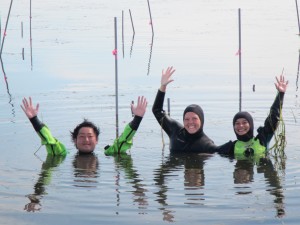
Kyosuke, Nicole, and Dr. Khwan Whankpetch during the breakdown of the ZEN experiment in Akkeshi, Japan
With 3 people in the water and 1 person on the boat handing out supplies and organizing the samples, we managed to break down the site in a smooth and efficient manner. Despite our relative lack of numbers, we managed to complete the experimental breakdown with its numerous sample collections in just two trips to the field site. I was amazed by this – not because we completed the work, but because we came to the field from four different countries. A Japanese (graduate student Kyosuke Momota), an American (me!), a Thai (visiting scientist. Dr. Khwan Whankpetch from Kasetsat University, Thailand) and a Filipino (visiting prospective student Venus Leopardas) all united together under the common mission of the Zostera Experimental Network – to produce great science.
The language barrier certainly posed a stumbling block in communicating with one another. This was especially challenging when difficulties arose and we had to work together to come up with a solution or when we were trying to find the best way to divide the work. It is a humbling experience for me because even though I am the foreigner to this country, communication is catered to my native tongue and we speak to each other in English. I wish I could say that I have learned more Japanese during my time here. I’ve mastered niceties such as “good morning” (ohayou gozaimasu) and “thank you” (arigato gozaimasu), but a full conversation is not possible – yet.
I continue to be astonished by how many languages the people I have met here not only understand but speak and read. For example, not only does Khwan speak Thai but she is also fluent in Japanese and English. Then there is the matter of the Japanese characters. In addition to learning the English alphabet, Japanese children learn three different sets of characters: hiragana, katakana, and kanji – there are over ONE THOUSAND characters in total! I have only mastered one – the “on” button for the washing machine.
Communicating in the field
Despite the language difficulties, we have learned to anticipate what one another needs and to find creative ways to express ourselves. By choosing our words carefully and speaking clearly we can usually get our point across. However, it is not to be underestimated how much you can say without saying anything at all. Through my experiences here in northern Japan I have come to realize how important thoughtful gestures and facial expressions are in average day to day communication. A smile definitely goes a long way! I have also found the ZEN experimental manual composed by Drs. Reynolds and Duffy to be invaluable. We use it both as a reference for the experimental procedures and as a tool for pointing out questions and providing answers. The methods videos accompanying the manual are also great as they show techniques that can be hard to explain even when everyone speaks the same language.
With all of the samples collected from the field, our attention turns back to the lab where the sample processing has begun. Kyosuke and I have been grateful for the help of Khwan and visiting researcher Ms. Venus Leopardas (Mindango State University at Naawan in the Phillipines). We are sad to see them leave as they return to their home countries, but we are happy to welcome ZEN student exchange fellow Rachel Gittman and undergraduate intern Ms. Minako Ito (Hokkaido University) to the Northern Japan team as we finish processing this week. It is great to be reunited with Rachel after working with her at the ZEN site in North Carolina. Stay turned for our upcoming co-authored blog entry “North and South unite!” There we will highlight our last week here in Akkeshi and our experiences as we travel across Japan before returning home. It’s incredible to think that our 6-week adventure is almost at an end!
Science and Site Seeing in Hiroshima
by Rachel Gittman (ZEN graduate student fellow)
Even though I have only been in Japan for three weeks, I am really beginning to feel a sense of home here. I have experienced so much since my last blog, but the most rewarding experience has been becoming part of the marine lab here in Hiroshima. Hori-san, Hamaoka-san, and Shimabukuro-san as well as the other members of the lab have made me feel both welcome and comfortable. We have lunch and afternoon tea together each day and although I am still struggling to communicate at times (I wish I could say my Japanese is improving, but I haven’t really gotten past basic greetings and responses), I am learning so much.
We have been very busy over the last few weeks with two ZEN experiments – a short term assay to examine the intensity of predation on mesograzers and a longer experiment to examine predator effects on the seagrass community. Thanks to the hard work and dedication of the lab, all of the experiments have been running smoothly thus far. After a week of cage building, we were ready to set up the longer predator exclusion experiment. Setting up the experiment here is a little different than setting it up in Virginia or North Carolina because our site is entirely subtidal and it gets pretty deep when the tide rises.
Hori-san and Shimbukoro-san used SCUBA to set the cages, while Hamaoka-san and I snorkeled above them, holding our cages on a long rope leash. The entire set-up took about six hours and I was able to capture about half of the set-up in a timelapse from shore.
Although we have been busy with our field experiments, the lab was kind enough to take me out for my birthday and gave me a great birthday present: cake and my own house shoes (very important to have in Japan). It was a wonderful birthday surprise and I am glad I was able to spend my birthday in Japan.
I share my birthday (August 6th) with the anniversary of the a very tragic day in history, the detonation of Little Boy, the first atomic bomb used in World War II. I was able to visit the Atomic Bomb dome, the remnants of the government building that was almost directly below where the detonation occurred, and the Peace Memorial Park. Visiting those sites was a humbling but positive experience because of ongoing efforts by the Japanese people to encourage world peace.
Beyond just seeing the sites, visiting Japan has also been about the experiences and more importantly the food! After much anticipation on my part as an avid sushi-lover, my hosts took me to a Japanese sushi restaurant in Hiroshima City. I could hardly contain my excitement as we sat down to order at the sushi counter. We had a perfect view of the chefs preparing the sushi and I was determined to try everything. Needless to say, I was not disappointed. The sushi was amazing and included some items that were new to me, such as squid, octopus, and urchin. The atmosphere, food, and my new friends made the night one that I am not likely to forget.
I can’t end the blog without sharing a few more of my site seeing adventures.
Over the weekend and this past week, I had the opportunity to visit some of most beautiful and historic places in this part of Japan: Miyajima and the Iwakuni Kintai bridge, in addition to the peace and atomic bomb memorials in Hiroshima City. Miyajima is a World Heritage Site just a few kilometers and a short train and ferry ride from the FRA Institute. The island contains many historic sites, including the Otorii Gate, Itsukushima Shrine, and Daishoin Temple, as well as nature trails that lead to the top of Mt. Misen.
After exploring the temples, shrines, and the public aquarium I decided to hike to the top of Mt. Misen to get a good view of the area. Along the way, I happened to meet a fellow North Carolinian, and we decided to hike up together. It was a good choice, because the 3km hike was very steep and the humidity and heat made reaching the top quite an accomplishment. The view was worth it though and the descent was much more pleasant.
I want to save some of my site seeing for another blog post, but I will briefly mention the Iwakuni Kintai bridge. Built in the early 1600s, it was deemed “indestructible” because of the superior engineering design and construction, well ahead of its time. The bridge is not only impressive from an engineering perspective, it is also incredibly beautiful. Although the bridge was partially destroyed in the early 20th century, it was restored to its original glory a few decades later and it still maintained in its original design and structure. Seeing the bridge just as the sun set was worth the wait. Having to wait for it to get dark also meant I could get more ice cream – this time I went for mango. I am pretty sure I have eaten more ice cream here in the past three weeks than I have for all of last year. What can I say except that it is just delicious!
First week in Akkeshi, Japan
by Nicole Kollars (ZEN graduate student fellow in Northen Japan)
I do not think my wetsuit had a chance to fully dry out this week as we were in the water at the ZEN field site everyday. With several experimental pushes (setting up an experiment to measure predator impacts on mesograzers, maintaining the main ZEN experiment, and surveys of the ambient predator community) it was a busy week for eelgrass science in northern Japan!
Science by canoe
A team of four made maintaining the ZEN experimental plots a smooth and efficient process. We used a canoe to keep bags of plaster blocks, extra cable-ties, and spare scissors easily accessible. While one person paddled around the plots and handed out supplies, the rest of us used mask and snorkel to change the old blocks out for the new. Luckily, the tide was at a good height to make snorkeling easy but the ever-present jellies still makes working at this site quite challenging!
Learning how to catch a fish
Before traveling to Japan I had never appreciated how creatively scientists can modify their use of the same or similar experimental gear to overcome obstacles posed by working under diverse field conditions. I’ve surveyed small aquatic predators before using a seine net (a large net attached to two poles dragged through the seagrass to capture fish and other predators). But, I had never seen one used quite like they do at the ZEN site in Akkeshi. We used a typical seine design (floats on top, weighted on the bottom), but with the addition of a tow net attached to one side of the seine. In the water, the seine net was walked out until completely stretched in one direction. Then we walked the ends of the net toward each other to form an enclosed circle. Moving very slowly, we gradually decreased the circle in size until all the fish were forced into the tow net. The tow net could then be emptied into a bucket and the fish counted, measured, and released. It was an effective design that did not require spending time picking the fish out of the netting of a traditional seine. I think this purse seining technique is similar to techniques that shrimpers and other commercial fishermen use to capture fish in the open ocean, but it’s not something I’d ever seen before. But that’s part of why I’m in Japan – to learn new techniques and do rigorous science at the same time.
A surprise trip to a tidal flat
To my absolute delight, after finishing work at the ZEN site one morning we swung by a tidal flat where I could collect samples of the local Gracilaria seaweed for my thesis research. While this species is introduced and invasive in the Southeastern USA, it is native to mudflats here in Akkeshi. The shallow water prevented the boat from getting too close to the shore, so we had to hike over one kilometer in shin-deep mud before we started seeing the seaweed. This happened to be the day when the sun shone bright and my 10 mm worth of neoprene grew unbearable as I made my way through the mud. But the end result of seeing Gracilaria in its native habitat was well worth the exertion and I was able to collect enough samples for my project and make some useful observations.
Interestingly, in the Akkeshi mudflats most of the Gracilaria is settled onto the shells of a local gastropod. This contrasts to the Southeastern USA where the decorator polychaete Diopatra attaches fragments of Gracilaria to its tube. In both cases, the seaweed is using an animal for substrate but through very different mechanisms. I also found amphipods living on Gracilaria. Similar to how the amphipods in the eelgrass beds are larger in Akkeshi than in the Carolinas, the amphipods I found on Gracilaria are gigantic compared to what I have seen in Charleston. A huge thanks goes out to Dr. Nakaoka for facilitating the endeavor, Dr. Honda and Kyosuke-san for hiking through the mud and collecting samples with me, and ZEN for bringing me to Japan!
All in a week’s work
Now at the week’s end my wetsuit finally has a chance to dry out and I look forward to a weekend of rest, a lab dinner party (with the promise of local Hokkaido seafood and good sake), and a canoeing trip up the Bekanbeushi River. “Work hard, play hard” definitely describes the life of a marine field ecologist here in Japan. Otsukaresama (thank you for your hard work) ZEN team!


